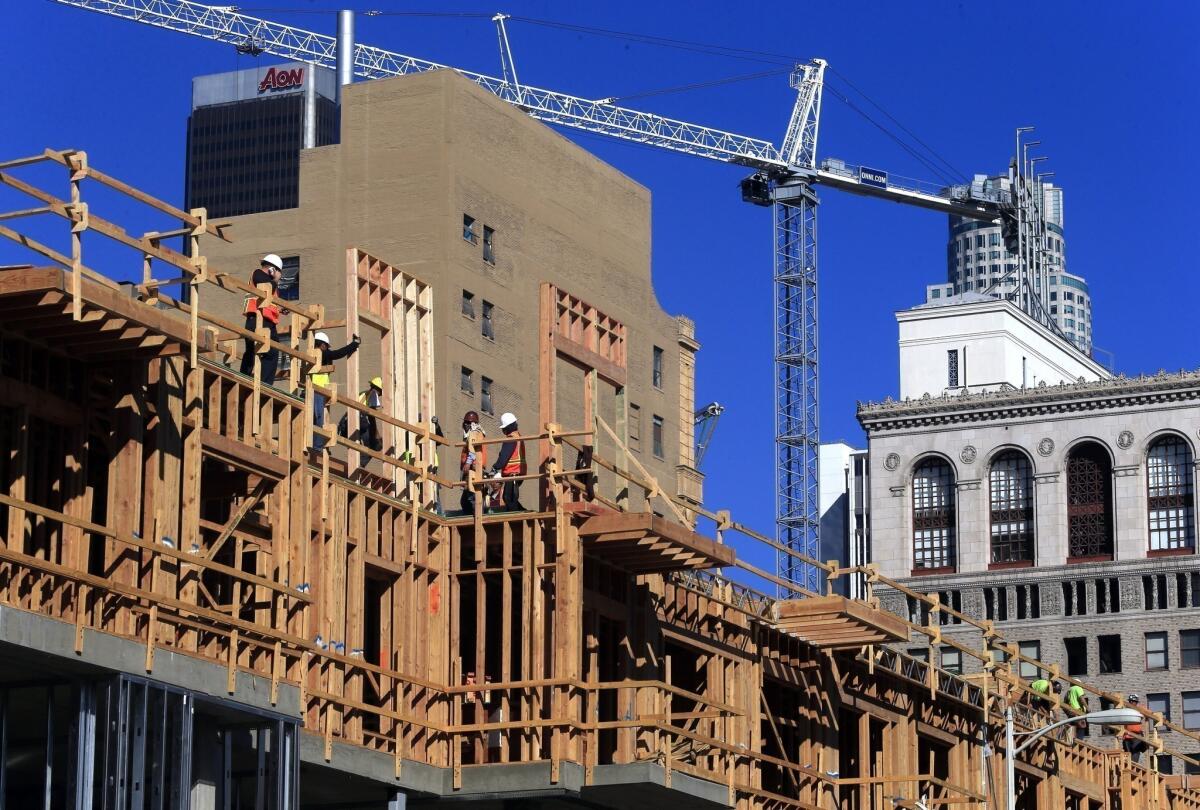Southland office market grows a bit stronger

- Share via
Despite a mixed performance in 2013, the Southern California office market improved slightly overall as the year finished with small increases in occupancy and rents.
The ever-popular Westside continued to lead the way as active leasing helped landlords fill empty space in their buildings and ratchet up rents. Orange County also held on to its upward trajectory.
“Things are getting better, little by little,” said Petra Durnin, director of research in the West for real estate brokerage Cushman & Wakefield.
Firms in creative businesses such as entertainment and technology helped drive average rents up 11 cents to almost $4 per square foot per month in Santa Monica in the fourth quarter, the brokerage said. That’s almost double the price of rent in the Warner Center office enclave in the San Fernando Valley, where a surge of insurance company leasing brought vacancy down to 16%.
Overall improvements in the region were less dramatic.
Office vacancy in Los Angeles, Orange, Riverside and San Bernardino counties was 17.3% at the end of the fourth quarter, improved only slightly from 17.9% a year earlier. Landlords asked for average monthly rents of $2.33 per square foot, an increase of 3 cents from the same period in 2012.
Southern California is lagging behind the rest of the country in economic improvement, said Arthur Jones, senior managing economist at CBRE Econometric Advisors.
“Historically, it takes Southern California longer to recover” from a national economic downturn, said Jones, who is based in Boston. “The cost of doing business is high; the cost of living is high. It puts you at a disadvantage as firms look to attract talent.”
Nevertheless, he said, employment is finally improving somewhat in Los Angeles and Orange counties. “The outlook is much better than it was two years ago. By the end of 2014 it will get really prosperous.”
One office category expected to see more growth in the months ahead is medical, said Martin Pupil, president of the western region for real estate brokerage Colliers International. The Affordable Care Act will probably lead numerous doctors to consolidate in larger, more central facilities than they have now, he said.
“A lot of medical offices are in the suburbs because doctors were building their own space,” Pupil said. “Now everything is going to go larger because healthcare will be dominated by large providers, the way insurance is working. Doctors are going to be gobbled up by health systems.”
Downtown Los Angeles, the second-largest office market in the region after the Westside, remains weak even as the neighborhood gets more attractions such as shops and restaurants. Vacancy in the central business district was more than 21% in the fourth quarter, up slightly from a year earlier.
Downtown landlords have had setbacks in recent years as longtime tenants shrink their offices. Some reductions in office space reflect staff cutbacks; others reflect management decisions to house more employees in less room as part of a nationwide movement toward more open layouts of offices.
The trend of companies shrinking their offices upon lease renewal may be coming to an end, though, said landlord Bert Dezzutti of Brookfield Office Properties. White-collar businesses such as law and accounting firms are “getting healthy,” he said, and some have recently taken more space instead of less at renewal time.
With its new amenities, including housing and substantial transportation options, downtown is attracting tenants from outside the area, he said. The office market that has been weak for decades is poised for a comeback.
“We’ve had a deeper hole to dig out of than any other metro area in the U.S.,” Dezzutti said at a recent meeting of the Central City Assn. “Recovery will be dramatic too.”
Twitter: @rogervincent
More to Read
Inside the business of entertainment
The Wide Shot brings you news, analysis and insights on everything from streaming wars to production — and what it all means for the future.
You may occasionally receive promotional content from the Los Angeles Times.











